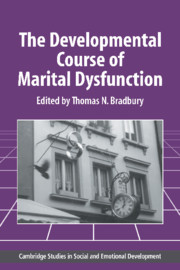Book contents
- Frontmatter
- Contents
- List of Contributors
- Foreword
- Introduction: The Developmental Course of Marital Dysfunction
- Part I Conceptual and Empirical Contributions
- 1 Communication in Early Marriage: Responses to Conflict, Nonverbal Accuracy, and Conversational Patterns
- 2 Marital Aggression, Quality, and Stability in the First Year of Marriage: Findings from the Buffalo Newlywed Study
- 3 Accommodation Processes During the Early Years of Marriage
- 4 The Psychological Infrastructure of Courtship and Marriage: The Role of Personality and Compatibility in Romantic Relationships
- 5 Happiness in Stable Marriages: The Early Years
- 6 Developmental Changes in Marital Satisfaction: A 6-Year Prospective Longitudinal Study of Newlywed Couples
- 7 The Development of Marriage: A 9-Year Perspective
- 8 Premarital Predictors of Relationship Outcomes: A 15-Year Follow-up of the Boston Couples Study
- 9 Optimizing Longitudinal Research for Understanding and Preventing Marital Dysfunction
- 10 Socialization into Marital Roles: Testing a Contextual, Developmental Model of Marital Functioning
- 11 Physical Aggression in Marriage: A Developmental Analysis
- Part II Invited Commentaries
- Author Index
- Subject Index
10 - Socialization into Marital Roles: Testing a Contextual, Developmental Model of Marital Functioning
Published online by Cambridge University Press: 13 October 2009
- Frontmatter
- Contents
- List of Contributors
- Foreword
- Introduction: The Developmental Course of Marital Dysfunction
- Part I Conceptual and Empirical Contributions
- 1 Communication in Early Marriage: Responses to Conflict, Nonverbal Accuracy, and Conversational Patterns
- 2 Marital Aggression, Quality, and Stability in the First Year of Marriage: Findings from the Buffalo Newlywed Study
- 3 Accommodation Processes During the Early Years of Marriage
- 4 The Psychological Infrastructure of Courtship and Marriage: The Role of Personality and Compatibility in Romantic Relationships
- 5 Happiness in Stable Marriages: The Early Years
- 6 Developmental Changes in Marital Satisfaction: A 6-Year Prospective Longitudinal Study of Newlywed Couples
- 7 The Development of Marriage: A 9-Year Perspective
- 8 Premarital Predictors of Relationship Outcomes: A 15-Year Follow-up of the Boston Couples Study
- 9 Optimizing Longitudinal Research for Understanding and Preventing Marital Dysfunction
- 10 Socialization into Marital Roles: Testing a Contextual, Developmental Model of Marital Functioning
- 11 Physical Aggression in Marriage: A Developmental Analysis
- Part II Invited Commentaries
- Author Index
- Subject Index
Summary
Theory and research in marital and family relations have produced notable advances in recent years. It is now possible to identify with considerable accuracy patterns of couple interaction that lead to emotional distress, marital unhappiness, and divorce (Bradbury & Karney, 1993; Gottman, 1990; Larsen & Olson, 1989). There is also a growing body of knowledge about the conditions under which families and their members either withstand or collapse under the onslaught of externally and/or internally induced stressors (Conger et al., 1990, 1992; Elder, 1974; Elder, Liker, and Cross, 1984).
These accomplishments seem all the more remarkable considering the rapid changes that are occurring in family life in the United States and throughout the world. Fundamental to these changes is the increasing proportion of married women in the labor force (Bielby, 1992). As women seek and obtain expanded opportunities and greater choices in education and jobs, it is inevitable that their roles as wives and mothers must change. For the majority of American families, traditional family roles and behavioral patterns are becoming anachronistic (cf. Gerson, 1985; Turner, 1990). As a result, established norms governing the intrafamily division of labor, the allocation of resources, and the distribution of authority among family members are being challenged and reassessed.
- Type
- Chapter
- Information
- The Developmental Course of Marital Dysfunction , pp. 312 - 342Publisher: Cambridge University PressPrint publication year: 1998
- 35
- Cited by



